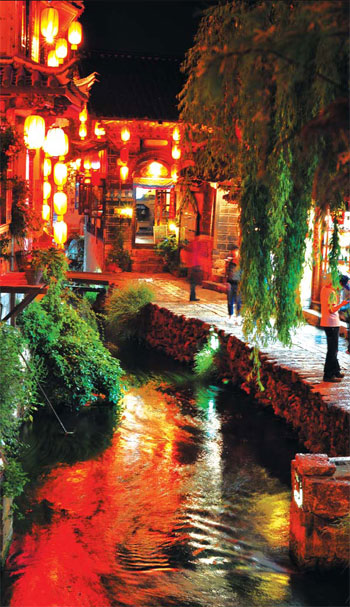A week in Lijiang
Updated: 2011-11-06 07:45
By Christopher Robiero (China Daily)
|
|||||||||
|
Lijiang is known for its stone bridges and canals with crystal clear water - a result of careful and intelligent irrigation mooted by a past chieftain. Now, bars and restaurants catering to tourist hordes line the banks of the flowing streams with goldfish swimming in them. Christopher Robiero / For China Daily |
Leaving the hype behind, Christopher Robiero takes a tourist mecca on its own terms.
Recently I embarked on a five-week backpacking trip through China's heartland, beginning in Shaanxi province through Sichuan all the way to the doorstep of Tibet, then made my way to Yunnan province.
One planned stop along the way was the much heralded city of Lijiang. Travelers I passed along the way had one of two reactions: abhorrence at my clich choice of destinations, or exultation over choosing such a marvelous town to pass through.
My mission was to snap a few memorable photos of the town and of the bike ride to a famous Lama temple outside of town.
Arriving in Lijiang, I was greeted by clear blue skies and welcoming sunshine, weather reminiscent of January in Southern California. The sun glistened on the cobbled streets and I started imagining all of the photos I would capture.
But there is no ebb to the wave of tourists in Lijiang, only a perpetual flow. This might cramp my picture-taking, but that wouldn't deter me from enjoying myself, as there appeared to be plenty of exploring to do in Old Town.
I let myself get lost in the labyrinth of streets in Lijiang. The city was built around an intricate but tidy maze of canals that are crossed by more than 300 stone bridges.
Photo opportunities abound, as do ways to spend money. I was delighted to find an artisan cheese shop and a gourmet bakery loaded with savory treats that would be good nosh for the long bike ride planned for the following day.
This hardly qualifies as experiencing the "real" Lijiang, but some may argue there isn't much authentic culture here to begin with. Most of the Naxi culture has been sucked dry by development companies and replaced with shops hawking mass-produced "authentic" handicrafts.
There is, in fact, nothing old about Old Town Lijiang. The city was razed after the earthquake in 1996, so many of the buildings are quite new. UNESCO tagged the city with World Heritage status but has also threatened to de-list the city due to over-development. That is an unlikely scenario, though the temptation is understandable, especially at night when Old Town's once-quiet streets are suddenly awash with tourists and cheesy Chinese pop music from bars and restaurants.
One item that can be found in abundance in Lijiang is Yunnan's famous pu-er tea.
This fragrant tea, a holdover from the southern route of the Silk Road is known as chamagudao, or Tea-Horse Caravan Route.
Stretching all the way from Burma to the Mediterranean Sea, this route was a critical trade link between the West and the East. Lijiang was an important hub for the traders heading west - it was often a stopping point to rest and acclimatize themselves before heading into Tibet.
Pu-er cha can be found in all of the tea houses and sold in large bricks or wheels. But be sure to look for the nei fei, the small ticket stuck onto the cake to ensure authenticity. You may even find a vintage year similar to what you would find on a wine bottle, which indicates the harvest year of the tea.
After spending a week in Lijiang, I found both stereotypes of the city correct.
It is certainly overcrowded, but the city is undeniably charming and enjoyable in spite of the throngs of travelers.
I am, of course, just one among them.
With the popularity of travel books like Lonely Planet and the internet's siren call with endless information, few places renowned for charm have remained unspoiled by tourists.
I would recommend it to anyone inclined to hop on a bicycle and venture away from the cobbled streets into the surrounding countryside.
After the music fades from the restaurants and bars of Old Town and the revelers retreat to their rooms, what's left is a tranquil and pristine sunrise that gleams above hundreds of tiled roofs, culminating in the moment I had set out to find the perfect photograph.
You can contact the writer at sundayed@chinadaily.com.cn.
